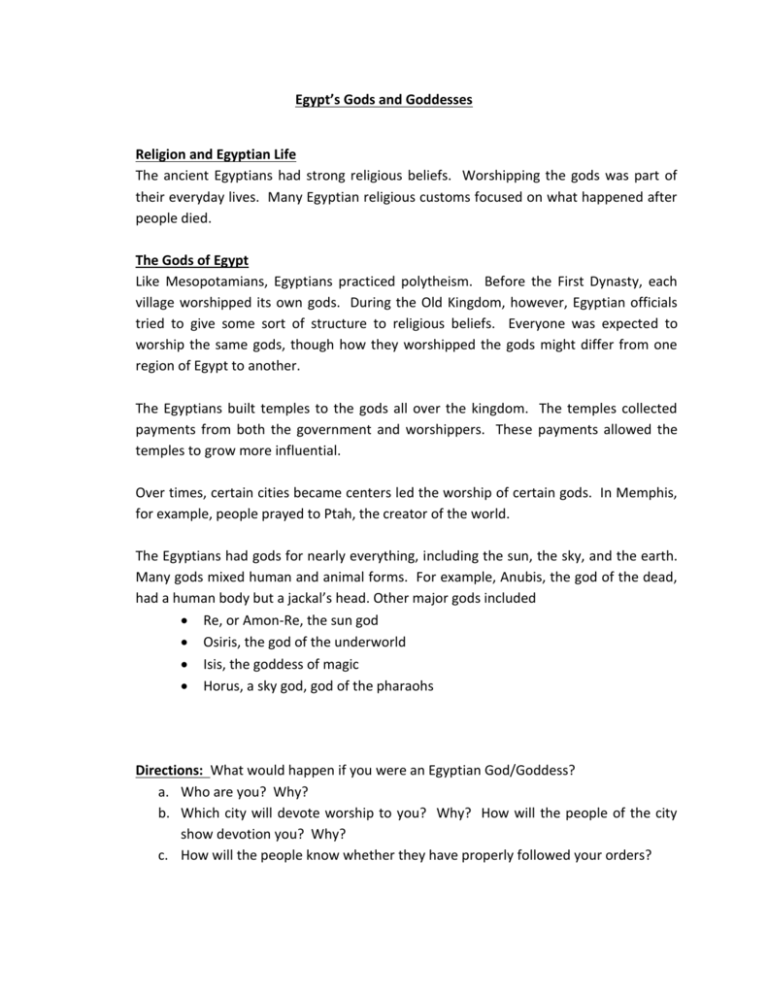Legacy of Egyptian Pharaohs
advertisement

Egypt’s Gods and Goddesses Religion and Egyptian Life The ancient Egyptians had strong religious beliefs. Worshipping the gods was part of their everyday lives. Many Egyptian religious customs focused on what happened after people died. The Gods of Egypt Like Mesopotamians, Egyptians practiced polytheism. Before the First Dynasty, each village worshipped its own gods. During the Old Kingdom, however, Egyptian officials tried to give some sort of structure to religious beliefs. Everyone was expected to worship the same gods, though how they worshipped the gods might differ from one region of Egypt to another. The Egyptians built temples to the gods all over the kingdom. The temples collected payments from both the government and worshippers. These payments allowed the temples to grow more influential. Over times, certain cities became centers led the worship of certain gods. In Memphis, for example, people prayed to Ptah, the creator of the world. The Egyptians had gods for nearly everything, including the sun, the sky, and the earth. Many gods mixed human and animal forms. For example, Anubis, the god of the dead, had a human body but a jackal’s head. Other major gods included Re, or Amon-Re, the sun god Osiris, the god of the underworld Isis, the goddess of magic Horus, a sky god, god of the pharaohs Directions: What would happen if you were an Egyptian God/Goddess? a. Who are you? Why? b. Which city will devote worship to you? Why? How will the people of the city show devotion you? Why? c. How will the people know whether they have properly followed your orders? Legacy of Egyptian Pharaohs Egyptians believed that burial sites, especially tombs, were very important. As a result, they built spectacular monuments in which to bury their rulers. The most spectacular of all were the pyramids, huge stone tombs with four triangle-shaped walls that met in a point on top. The Egyptians began to build pyramids during the Old Kingdom. Some of the largest pyramids ever constructed were built during this time. Many of these huge structures are still standing. The largest is the Great Pyramid of Khufu near the town of Giza. It covers more than 13 acres at its base and stands 481 feet high. This single pyramid took more than 2 million limestone blocks to build. Historians are still not sure exactly how Egyptians built the amazing pyramids. They are, however, amazing feats of engineering, the application of scientific knowledge for practical purposes. Burial in pyramid demonstrated a pharaoh’s importance. The size was a symbol of the pharaoh’s greatness. The pyramid’s shape, pointing to the sides, symbolized the pharaoh’s journey to the afterlife. The Egyptians wanted the pyramids to be spectacular because they believed that the pharaoh, as the link to the gods, controlled everyone’s afterlife. Making the pharaoh’s spirit happy was a way of ensuring a happy afterlife for every Egyptian. Directions: If you had access to all resources, how would you deal with ensuring your legacy as an Egyptian Pharaoh? a. What would you burial site look like? b. What spectacular monuments would you have built for you? Why? c. What will occur to the Egyptian people if you are pleased with your burial site? Displeased? Why? Egyptians After Death Emphasis on the Afterlife Much of Egyptian religion focused on the afterlife, or life after death. The Egyptians believed that the afterlife was a happy place. Paintings from Egyptian tombs show the afterlife as an ideal world where all the people are young and healthy. The Egyptian belief in the afterlife stemmed from their idea of Ka, or a person’s life forces. When a person died, his or her Ka left the body and became a spirit. The Ka, however, remained linked to the body and could not leave its burial site. The Ka had all the same needs that the person had when he or she was living. To fulfill the Ka’s needs, people filled tombs with objects for the afterlife. These objects included furniture, clothing, tools, jewelry, and weapons. Relatives of the dead were expected to bring food and beverages to their loved ones’ tombs so the Ka would not be hungry or thirsty. Burial Practices Egyptian ideas about the afterlife shaped their burial practices. Egyptians believed that a body had to be prepared for the afterlife before it could be buried. This meant the body had to be preserved. If the body decayed, its spirit could not recognize it. That would break the link between the body and spirit, The Ka would then be unable to receive the food and drink it needed to have a good afterlife. To keep the Ka from suffering, the Egyptians developed a method called embalming. Embalming allowed bodies to be preserved for many, many years as mummies, specially treated bodies wrapped in cloth. A body that was not embalmed would decay quickly. The mummy was placed in in a coffin. Relatives often wrote magic spells inside the coffin to help the mummy receive food and drink. Only royalty and other members of Egypt’s elite, or people of wealth and power, could afford to have mummies made. Peasant families buried their dead in shallow graves at the edge of the desert. The hot dry sand and lack of moisture preserved the bodies naturally. Directions: Why don’t you devise you own way to ensure afterlife is a happy place for you? a. What objects would you wish to have with you? Why? b. What would your mummification process be like? Why? c. Which relatives would you wish to write a magic spell for you? Why? What would these magic spells say about you?









